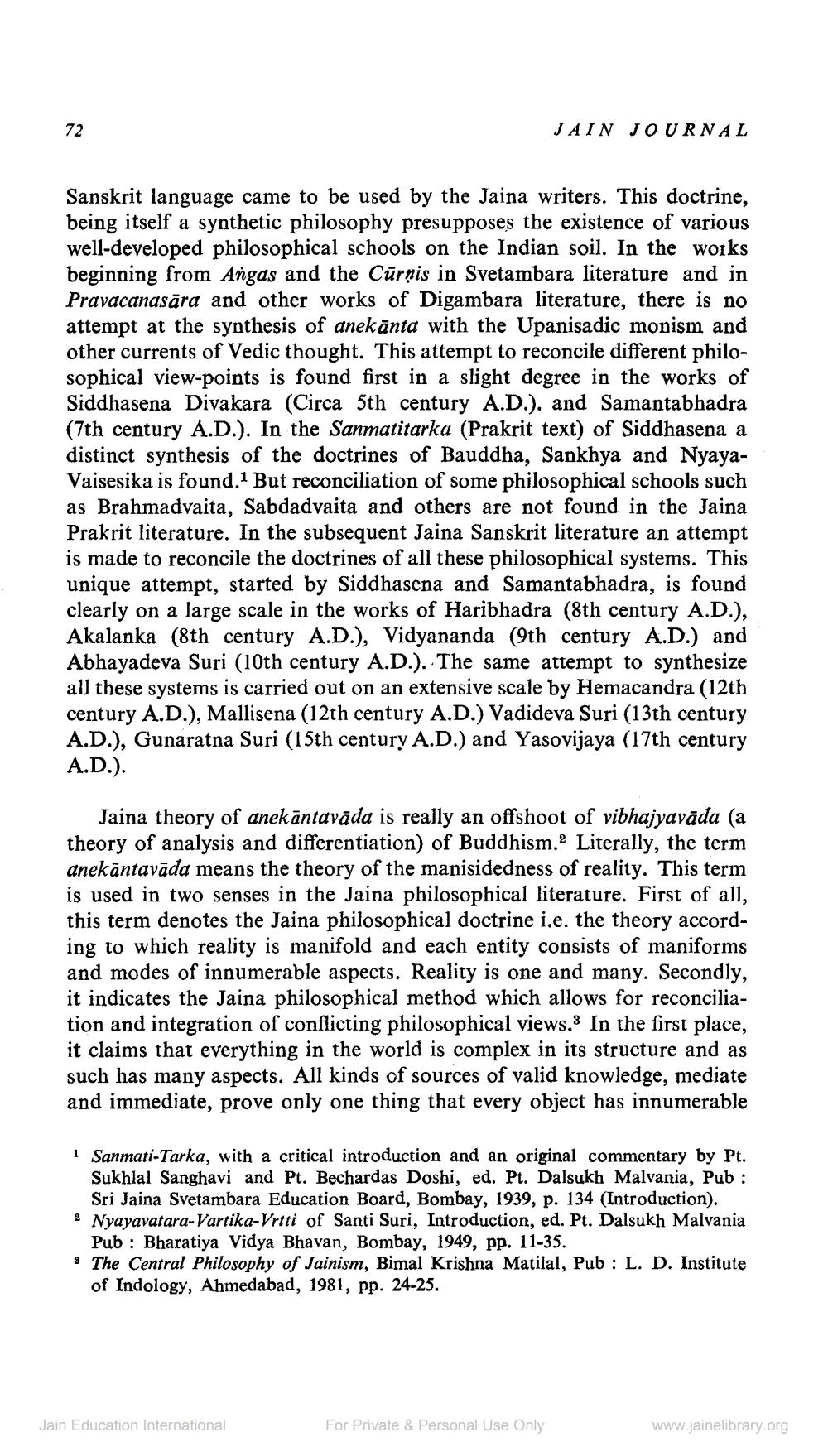________________
72
Sanskrit language came to be used by the Jaina writers. This doctrine, being itself a synthetic philosophy presupposes the existence of various well-developed philosophical schools on the Indian soil. In the works beginning from Angas and the Curnis in Svetambara literature and in Pravacanasāra and other works of Digambara literature, there is no attempt at the synthesis of anekanta with the Upanisadic monism and other currents of Vedic thought. This attempt to reconcile different philosophical view-points is found first in a slight degree in the works of Siddhasena Divakara (Circa 5th century A.D.). and Samantabhadra (7th century A.D.). In the Sanmatitarka (Prakrit text) of Siddhasena a distinct synthesis of the doctrines of Bauddha, Sankhya and NyayaVaisesika is found.1 But reconciliation of some philosophical schools such as Brahmadvaita, Sabdadvaita and others are not found in the Jaina Prakrit literature. In the subsequent Jaina Sanskrit literature an attempt is made to reconcile the doctrines of all these philosophical systems. This unique attempt, started by Siddhasena and Samantabhadra, is found clearly on a large scale in the works of Haribhadra (8th century A.D.), Akalanka (8th century A.D.), Vidyananda (9th century A.D.) and Abhayadeva Suri (10th century A.D.). The same attempt to synthesize all these systems is carried out on an extensive scale by Hemacandra (12th century A.D.), Mallisena (12th century A.D.) Vadideva Suri (13th century A.D.), Gunaratna Suri (15th century A.D.) and Yasovijaya (17th century A.D.).
JAIN JOURNAL
Jaina theory of anekāntavāda is really an offshoot of vibhajyavāda (a theory of analysis and differentiation) of Buddhism.2 Literally, the term anekantavāda means the theory of the manisidedness of reality. This term is used in two senses in the Jaina philosophical literature. First of all, this term denotes the Jaina philosophical doctrine i.e. the theory according to which reality is manifold and each entity consists of maniforms and modes of innumerable aspects. Reality is one and many. Secondly, it indicates the Jaina philosophical method which allows for reconciliation and integration of conflicting philosophical views. In the first place, it claims that everything in the world is complex in its structure and as such has many aspects. All kinds of sources of valid knowledge, mediate and immediate, prove only one thing that every object has innumerable
1 Sanmati-Tarka, with a critical introduction and an original commentary by Pt. Sukhlal Sanghavi and Pt. Bechardas Doshi, ed. Pt. Dalsukh Malvania, Pub: Sri Jaina Svetambara Education Board, Bombay, 1939, p. 134 (Introduction).
2 Nyayavatara-Vartika-Vrtti of Santi Suri, Introduction, ed. Pt. Dalsukh Malvania Pub Bharatiya Vidya Bhavan, Bombay, 1949, pp. 11-35.
The Central Philosophy of Jainism, Bimal Krishna Matilal, Pub: L. D. Institute of Indology, Ahmedabad, 1981, pp. 24-25.
Jain Education International
For Private & Personal Use Only
www.jainelibrary.org




